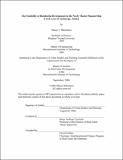| dc.contributor.advisor | Brian Anthony Ciochetti. | en_US |
| dc.contributor.author | Debenham, Shaun T. (Shaun Todd), 1973- | en_US |
| dc.contributor.other | Massachusetts Institute of Technology. Dept. of Urban Studies and Planning. | en_US |
| dc.coverage.spatial | n-us-ak | en_US |
| dc.date.accessioned | 2005-09-06T19:54:47Z | |
| dc.date.available | 2005-09-06T19:54:47Z | |
| dc.date.copyright | 2004 | en_US |
| dc.date.issued | 2004 | en_US |
| dc.identifier.uri | http://hdl.handle.net/1721.1/26740 | |
| dc.description | Thesis (S.M.)--Massachusetts Institute of Technology, Dept. of Urban Studies and Planning, 2004. | en_US |
| dc.description | This electronic version was submitted by the student author. The certified thesis is available in the Institute Archives and Special Collections. | en_US |
| dc.description | Includes bibliographical references (leaf 70). | en_US |
| dc.description.abstract | The aim of this thesis is to determine if a 40 unit condominium complex located in the Ship Creek area in Anchorage, Alaska, is financially feasible. Historically, Ship Creek has been an industrial area but recently the Alaska Railroad has master planned the area and hopes to entice developers to revitalize the area into a vibrant pedestrian friendly "village." Because Ship Creek is close to downtown, Ship Creek, Cook Inlet, and recreational trails, development in this area could be very desirable. A Market Analysis performed for this area determined that Anchorage's economy should continue with slow gradual growth. Also, it was forecasted that the demand for new condos in 2005 will be 340 units and that the supply of new condos will be 358. The proposed project will target the empty nester age group. Construction on the project is assumed to start in the third quarter of 2004 and end four quarters later in 2005. The benefit value of the development is calculated to be $9,887,988. Therefore the Net Present Value of the project is +$95,087. A positive NPV means the project should be pursued. An IRR for the Net Cash Flows (all equity) was calculated to be 20% and the IRR for the equity contributor was calculated to be 59%. Although the "numbers" indicate that the project should be pursued, the numbers can not incorporate one important risk. Ship Creek is far from the vision created in the master plan. The proposed project risks being the first major redevelopment in the area. The proposed project is cautiously recommended. Due to Anchorage's dwindling supply of developable land, Ship Creek will eventually be redeveloped. Ship Creek's close proximity to downtown, combined with the belief that Anchorage has unmet demand for empty nester housing, makes the Ship Creek area attractive. However, because this development is one of the first major redevelopments in the area it is risky. | en_US |
| dc.description.statementofresponsibility | by Shaun T. Debenham. | en_US |
| dc.format.extent | 87 leaves | en_US |
| dc.format.extent | 5144327 bytes | |
| dc.format.extent | 5700847 bytes | |
| dc.format.mimetype | application/pdf | |
| dc.format.mimetype | application/pdf | |
| dc.language.iso | en_US | |
| dc.publisher | Massachusetts Institute of Technology | en_US |
| dc.rights | M.I.T. theses are protected by copyright. They may be viewed from this source for any purpose, but reproduction or distribution in any format is prohibited without written permission. See provided URL for inquiries about permission. | en_US |
| dc.rights.uri | http://dspace.mit.edu/handle/1721.1/7582 | |
| dc.subject | Urban Studies and Planning. | en_US |
| dc.title | The feasibility of residential development in the newly master planned Ship Creek area of Anchorage, Alaska | en_US |
| dc.type | Thesis | en_US |
| dc.description.degree | S.M. | en_US |
| dc.contributor.department | Massachusetts Institute of Technology. Department of Urban Studies and Planning | |
| dc.identifier.oclc | 59820850 | en_US |
